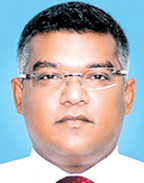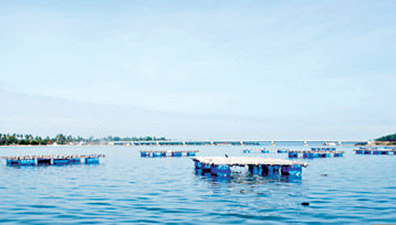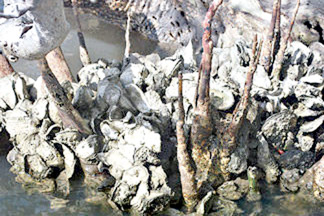|
Master plan to improve fisheries industry and promote investment:
NARA to develop aquaculture
By Mohammed Naalir
|

NARA Chairman,
Dr. S.G. Samarasundera
|
The National Aquatic Resources Research and Development Agency
(NARA), the research arm of the Fisheries Ministry plans to implement
various marine research programs along the Sri Lankan waters, NARA
Chairman, Dr. S.G. Samarasundera told the 'Sunday Observer'.
He said NARA provides all support to the Fisheries Ministry to
achieve self-sufficiency in fish production. Aqua products have become
the main commodity worldwide compared to other products.
Shrimp farming and fresh water ornamental fish farming are practised
in Sri Lanka for commercial purposes. A few marine aquarium fish are
also being bred in captivity. Other commercial level fin fish and shell
fish aquaculture is in a developing stage. Since there is a vast natural
resource and suitable environmental conditions for aquaculture, Sri
Lanka has much potential to develop the sector which contributes to the
increase of national fish production, Dr. Samarasundara said. He said
the sustainable use of the fishery resource is important to achieve the
production targets. It can be achieved by promoting the sustainable
utilisation of the unexploited high demand fin and shell fish species to
be popularised on a commercial scale which would lead the way to higher
incomes and export earnings.
The Chairman said: "Aquaculture and farming contribute significantly
to the global fish and shell fish production. It is a highly developed
industry in the East Asian region. Mollusk, finfish, shellfish and sea
cucumber culture is at its very initial stage in Sri Lanka.
|

Raft culture of mussels |
"With the 30-year war against terrorism and the most suitable sites
being in the North, aquaculture potential was hardly exploited.
Fisheries and Aquatic Resources Development Minister Dr. Rajitha
Senaratne has instructed NARA to identify the resources and develop a
master plan to develop the industry. With the assistance of consultants
from Korea and Japan, and local expertise, NARA is producing an action
plan to develop the industry and create investment opportunities in the
field of aquaculture.
"NARA has identified commercially important marine species such as
the fin fish species namely; sea bass, grouper and milk fish shell fish
species such as shrimps mud crab sea crab spiny lobsters and species
such as sea cucumber which are naturally available and are high value
species for aquaculture in Sri Lanka. Locally available sea weed species
such as Gracilaria sp. and exotic sea weed varieties, such as
Kappaphycus alverezii are commercially important aquatic plant species
for farming.
 |
| A female crab
with eggs |
 |
| Oysters cling
on to mangrove roots |
 |
| Oyster |
"The world mollusc production amounted to 13.1 million metric tons in
2008. Asia contributed almost 73 percent while only 27 percent came from
the rest of the world. Molluscs culture contributes 20 percent from the
total aquaculture production of Asia. The major mollusc producing
countries in the ASEAN region are Japan, Korea and China. Among the
species of bivalves cultured and harvested from the wild in the region
are oysters, cockles and mussels.
"Oysters are very nutritious. They contain a high level of glycogen
which makes an excellent source of energy that reduces the work load of
the pancreas of the human body. Complex sugars in the bloodstream must
be broken down into glycogen by enzymes which the pancreas secretes
before they are stored in the liver. Glycogen provided from oysters will
reduce the work load of the pancreas.
"Edible bivalve species namely oysters, mussels clams, cockles and
other economically important species are naturally available in marine
and brackish water bodies throughout the coastal areas of Sri Lanka.
"At present bivalve farming is also at its initial stage and since
there is a great potential for development of the industry in Sri Lanka,
the Divinaguma program under the patronage of Minister Basil Rajapaksa
has initiated 2 main programs on Oyster and Mussel culture in the Mannar
and Tricomalee districts. At present we have identified around 100 low
income families and set up culture sites as a livelihood development
project. I would like to promote this to the private sector for
investment as it is a profitable industry.
There is a high demand for oyster and mussels worldwide and NARA is
willing to give the necessary technical support to any private party who
would invest in the industry. NARA is also starting a market research
for the local consumption of oyster and mussel as the booming hotel
industry requires large quantities. We are able to direct the parties
interested to the best sites with the most natural resources. These
sites are mainly in the North Western and North Eastern provinces", Dr.
Samarasundara said.
At present, the minimum value of a kilo of sea cucumber is about 140
USD. NARA has the technical skills in breeding sand fish and would wish
the private sector to take the initiative to develop farms and be a part
of this lucrative industry. Crabs of the genus Scylla are strongly
associated with mangrove areas throughout the Pacific and Indian Oceans
and form the basis of substantial fishery and aquaculture operations.
There are two basic forms of land-based mud crab aquaculture:
fattening of crabs with a low flesh content, and grow-out of juveniles
to market size.
Fattening is a very profitable activity, employing high densities of
crabs and low costs. However, total production is low because of
mortalities due to cannibalism, NARA chairman said.He said, "further
research is required into the habitat preferences of each species so
that production techniques can be modified to suit their respective
requirements.
With advances in the hatchery production of mud crab juveniles for
stocking into ponds and enclosures, the future of mud crab aquaculture
looks promising.
"There has been an artisanal mud crab fishery in the country for
several decades. With the high demand and export of crab, this sector
generates foreign exchange and constitutes an important means of income
generation for local communities.
However, the increase in coastal populations, the high demand for mud
crabs from foreign countries, the ease of collection in shallow coastal
waters by traps, gill nets, scoop nets, hand picking and the
introduction of fattening for soft shell crabs have all combined to
cause overfishing of this valuable resource.
Despite the importance of mud crabs, information of their biology and
ecology which is crucial for management is scarce in Sri Lanka".
NARA has planned to provide the following services and facilities for
investors interested in the country such as, training, technology
transfer, management and monitoring support and health certification for
export.
Trincomalee district: It has an area of 2,727 square kilometres. It
poses sheltered bays such as Thabalagam Bay, Kinniya Bay, Clappenberg
Bay and Cod Bay which are suitable areas for sea farming development.
Mannar district: Mannar has one of the biggest natural resources of
oyster in Sri Lanka.
Puttalam district: This area has a huge potential for most of the
discussed species because the Puttalam District has extensive lagoon and
canal systems, and because of its proximity to Colombo, it is one of the
most suitable areas for marine aquaculture. |



